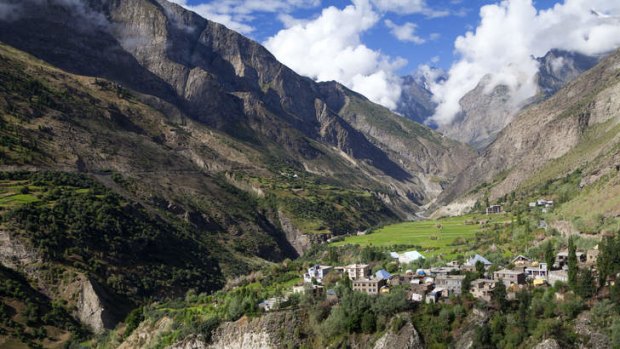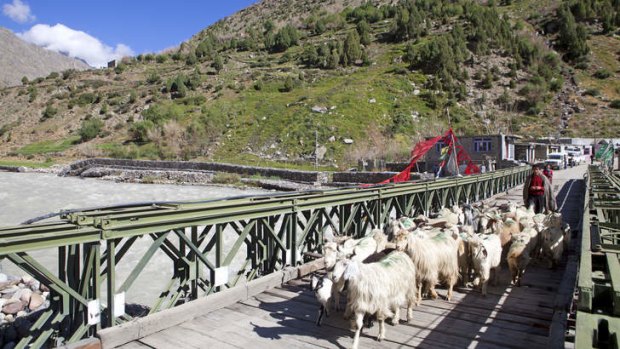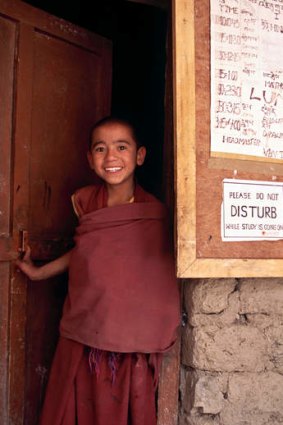Andrew Bain takes an unhurried trip through the soaring terrain of the ancient Manali-Leh highway.
In the Indian city of Manali, birds of prey hang in the sky like marionettes. Rhesus macaques scuttle through the trees, and a humid blanket of mist clings to the hilltops.
Pressed into a lush valley in the Himalayan foothills, the Himachal Pradesh city is celebrated as a place of apples and cedars, but it's equally famous as the start of an epic highway journey across the mountains to Leh, the Ladakhi city on the high desert of the Tibetan Plateau that is its visual opposite.

Keylong village.Credit: Andrew Bain
The 480-kilometre highway is unarguably one of the world's most spectacular road trips, crossing five high Himalayan passes and threading through some of the most humbling mountain terrain on Earth. And yet for most travellers it's a motion picture, seen but not felt as it's hurried through on a bus in a couple of days.
Along the highway, towns are few and minor, and there are no temples, tigers or Taj Mahals, but allow time and the trip amply rewards the effort. On a recent journey, I spent eight days edging along this mighty road through the Himalayas, and the destinations quickly became almost incidental to the journey.
The highway is exceptional in its design, following a maze of valleys and passes through the planet's highest mountain range. Though it has more than 8000 metres of climb there's barely a truly steep moment, allowing for the limitations of the heavy military vehicles that were a major reason for its construction 26 years ago (the road forms part of a land link into disputed Kashmir).

Goat herd crossing a road bridge at Darcha.Credit: Andrew Bain
Out of Manali, the journey begins along the banks of the Beas River, where rock faces reach down to the road and prayer flags colour a forest as matted as dreadlocks.
Soon the land seems to fold in on itself, the wide valley contracting into narrow gorges.
Less than 50 kilometres from Manali, the village of Marhi sits at the foot of Rohtang La, the first of the highway's mountain passes. For most travellers, Marhi is a chance for a tea break at a roadside stall or something stiffer from the well-stocked liquor stall. For us Marhi is a first night's camp, our tents spread beside one of its few permanent buildings.

A young monk.Credit: Getty Images
The road over Rohtang La offers little choice but to slow down. Due to the region's fierce winter conditions, the highway is only open about four months of the year - June to September - a time that coincides with the monsoon, and on the climb to Rohtang La, mud oozes over the road.
At almost 4000 metres above sea level Rohtang La is the lowest of the highway's five passes, and here the road changes valleys. The monsoonal greenery is suddenly behind us, and the high Himalayas are now ahead.
Each pass over the next week has a sense of instant transition, with the road rising out of one distinct landscape and descending into another. Wide gorges transform into sandy, velvet-smooth mountain slopes that look almost airbrushed into the scene, which morph in turn into barley fields and Buddhist monasteries crimped onto sharp rocky ridges.
String it together at speed and it can be difficult to detect the land's nuances - mountain follows mountain follows mountain - but at a crawl it's far more revealing.
I climb to small hilltops and watch villagers work the patchy fields, or shepherds leading herds of goats across saltpans. A butter-yellow building among fields of potatoes turns out to be a monastery of the Yellow Hat school, the Dalai Lama's Buddhist order. Thirty kilometres off the highway, springs well up beside Tsokar Lake, creating a desert oasis of yaks and wild donkeys.
For most of its length, the highway is blessedly quiet, and it's like finding an India that's fallen through the cracks.
The last of the mountain passes is also the highway's literal high point, with 5350-metre Taglang La sometimes touted as the second-highest motorable pass in the world. Beyond it, the road dips into the high desert of the Indus Valley, where all colour seems to have settled to the valley floor. Brown lifeless mountains rise above a shagpile of poplars, willows and barley fields, with pockets of greenery leaking out from side valleys.
On the descent towards the Indus Valley, we make our final camp in the tiny village of Rani Bagh. Above us, towers of rock stand up inside eroded ravines, and the riverside cliffs are stained as purple as berries and as green as copper. Ruined ridge-top palaces crumble down the slopes.
As the sun dips, the mountains and barley fields flare with sunset light. The highway is now almost silent, but for the tinkle of a herd of goats heading for home. There's not a single thing to do, and it's utterly perfect.
The writer travelled courtesy of Exodus Travels.
TRIP NOTES
GETTING THERE
Singapore Airlines has a fare to Delhi from Sydney and Melbourne for about $1203 low-season return, including tax. Fly to Singapore (about 8hr) and then to Delhi (5hr 35min). Jet Airways operates 80-minute flights from Delhi to Leh beginning at about $125 one-way. From Delhi, it's a 15-hour bus ride to Manali. Australians require a visa for a stay of up to six months.
TOURING THERE
Exodus Travel's 16-day A Himalayan Journey ($1925) trip covers the Manali-to-Leh highway. The slowest, and most challenging, way to see the Manali-to-Leh highway is to cycle it. The tough ride usually takes between eight and 10 days, averaging about 60 kilometres a day. Exodus's Manali to Leh Ride ($2280) cycles along the length of the highway.
MORE INFORMATION
Sign up for the Traveller Deals newsletter
Get exclusive travel deals delivered straight to your inbox. Sign up now.